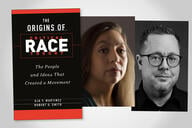You have /5 articles left.
Sign up for a free account or log in.
For two years, Daisy Verduzco Reyes, an assistant professor at the University of Connecticut, sat quietly in the background during Latino student organization meetings at three different colleges. She listened to determine how students thought and talked about what it meant to be Latino and paid attention to what was discussed, what kinds of events were planned and whether or not the group was political.
Beyond that, she also listened to see how the students deliberated with each other, recruited new members to their organizations and fostered (or didn't foster) a sense of community. Reyes presents her findings in her new book, Learning to Be Latino: How Colleges Shape Identity Politics (Rutgers University Press), which walks the reader through Latino student experiences at the three unnamed institutions.
Via email, Reyes answered some questions about her book.
Q: Your book examines how students at three different types of institutions -- a liberal arts college, a research university and a regional public university -- determine what it means to be Latino. What are the biggest differences you found among students at each type of each institution?
A: I found that each of these institutions has a distinct racial climate, which is created through several campus features like student-faculty ratio, student body demographics, residential patterns and diversity programming, among other factors. And these racial climates in turn shaped how Latino students experienced their institution. These settings fostered different types of interactions among Latino peers, non-Latino students, faculty and administrators.
For example, the prestige of the liberal arts college coupled with the affluence of the student body fostered more experiences with racial microaggressions and marginalization among Latino students when compared to Latino students at the research university and the regional public university. Experiences of racial marginalization led the students to hold broad definitions of what it means to be Latino, emphasizing heterogeneity and solidarity.
In contrast, the research university studied gave one of the Latino student groups more resources (mainly an office space in the multicultural center), which fostered some competition between this group and the other Latino student organizations. At this campus, students drew boundaries around Latino identities, at times questioning each other's ethnic authenticity. When students claimed to be Latino on this campus, they felt compelled to explain and defend what that meant. For example, students answered questions about their identities with responses like "I'm Latina, although I don't know all the foods or music."
The regional public university is a Hispanic-serving institution with close to half the student body being of Latino origins (primarily Mexican, Salvadoran and Guatemalan). However, these students rejected panethnic labels, such as "Latino" and "Hispanic." They preferred national origin terms (for example, "Mexican" and "Salvadoran"), and didn't see the need to use panethnic labels. Latinos are not underrepresented at this institution and do not experience racial microaggressions on campus, hence there is less need to identify panethnically in this type of setting.
In sum, the racial climates shaped how Latino students came to understand the meaning of identity labels and their utility.
Q: How did you observe political and nonpolitical Latino student organizations consider and employ their identities differently?
A: I only observed differences in this at the research university, where there were conflicts and tensions between the political and the nonpolitical student organizations. This was the only campus where students felt the need to really explain how and why they were Latino/Chicano. Some of the politically oriented students used the label "Chicano" to signal a political position, however, several of the politically oriented students found this label problematic. They felt it signaled a "radical" and "militant" identity and wanted to distance themselves from this term despite their political commitments. The students in the nonpolitical group on this campus felt the need to state their desire to avoid politics and to distinguish themselves from the politically oriented group. However, these nonpolitical students expressed that, despite this, they too were "Latino."
Q: On what aspects of identity were students most likely to agree? When were they most likely to disagree?
A: The students seem to share concerns about the educational advancement of Latinos broadly, including their own. They also shared concerns about creating a just immigration policy.
However, I did find variation across campuses in how much heterogeneity and diversity the students assume there is amongst Latinos and whether that diversity poses a challenge to solidarity. At the liberal arts college, students emphasized heterogeneity among Latinos yet punctuated the possibility of solidarity. At times students at the research university saw diversity as a threat to Latino unity within organizations. And at the regional public university, students painted more monolithic portrayals of Latinos.
Q: Of the three types of universities, which did you find creates a more welcoming environment for Latino students?
A: I think this depends on what you mean by welcoming. I'd say that the regional public university is welcoming in the sense that there is little social expectation from students; in this commuter campus, students can be anonymous beyond their time in class. Students here do not face racial marginalization or social sanctions because they spend little time on campus.
The liberal arts college has created several programs to foster integration among students and to integrate underrepresented groups. The campus size allows these programs to work, however, this is also where you see the most racialization given the affluence on campus.
Q: Who is one policy or decision maker you hope reads your book, and what do you hope they do as a result?
A: Administrators with access to resources on campus and the power to build institutions. I'd like campuses to broaden, and redistribute, the responsibility of creating welcoming environments from underrepresented students themselves to include the entire student body. I'd like to see students, faculty and administrators from majority groups take on these tasks.
For example, at the liberal arts college, I think a first-year seminar on educational inequality and microaggressions should be a requirement in all students' curricula. At the research university and the regional public university, I think a first-year seminar required of all students should teach about the history of student activism on that campus. This way, students will understand why certain institutions and programs were created on their campus.




